Copper Clad Steel Strips Produced by a Modified Twin-Roll Casting Process
Abstract
:1. Introduction
2. Materials and Methods
2.1. Caster and Casting Experiments
2.2. Strip Characterization
3. Results
3.1. The Casting Process
3.2. Bonding Interface
3.2.1. Flat Interface
3.2.2. Cracks
3.2.3. Localized Melting
3.2.4. Folds
3.2.5. Intermixed Region
3.3. Rolling and Bending Tests
4. Discussion
- A stochastically structured surface leading to a more homogeneous solidification of the melt and a cast strip with less defects. This should also help to form a more uniform bonding interface.
- Defined peaks in roughness to melt and mix with the steel phase and therefore creating a defined intermixed region between the two cladding partners.
5. Conclusions
- It was shown that it is possible to create copper clad steel strips via the modified twin-roll casting route. Strips with a thickness ratio between cast and cladding strip of roughly 1.5:1 and a final thickness between 3.0 mm and 3.3 mm were produced this way.
- Due to copper’s thermal properties and their influence on the process, it was not possible to keep stable casting conditions for longer time periods. To achieve this, constructional adaptation of the experimental set-up and maybe a change in process control are needed to counter process oscillations.
- The unstable bonding conditions lead to a multitude of different characteristics within the bonding interface. However, for all different characteristics, bonding was achieved by element diffusion, and any mechanical locking was of minor importance to the bond. Especially important hereby was the diffusion of carbon, which agglomerated at the bonding interface.
- Despite the resulting irregular morphology of the bonding interface, the bond performed well in rolling and bending tests.
Author Contributions
Funding
Acknowledgments
Conflicts of Interest
Abbreviations
| TRC | Twin-roll (strip) casting |
| Cu | Copper |
| Fe | Iron |
| C | Carbon |
| FE | Finite Element |
| SEN | Submerged entry nozzle |
| EPMA | Electron probe microanalysis |
| SEM | Scanning electron microscope |
References
- Lesuer, D.R.; Syn, C.K.; Sherby, O.D.; Wadsworth, J.; Lewandowski, J.J.; Hunt, W.H. Mechanical behavior of laminated metal composites. Int. Mater. Rev. 1996, 41, 169–197. [Google Scholar] [CrossRef]
- Bambach, M.; Pietryga, M.; Mikloweit, A.; Hirt, G. A finite element framework for the evolution of bond strength in joining-by-forming processes. J. Mater. Process. Technol. 2014, 214, 2156–2168. [Google Scholar] [CrossRef]
- Jamaati, R.; Toroghinejad, M.R. Cold roll bonding bond strengths: Review. Mater. Sci. Technol. 2013, 27, 1101–1108. [Google Scholar] [CrossRef]
- Ferry, M. Direct Strip Casting of Metals and Alloys: Processing, Microstructure and Properties; Woodhead Publishing in Materials, Woodhead Pub. and Maney Pub. on Behalf of The Institute of Materials, Minerals & Mining: Cambridge, UK, 2006; ISBN 9781845690496. [Google Scholar]
- Kopp, R.; Hagemann, F.; Hentschel, L.; Schmitz, J.; Senk, D. Thin-strip casting—Modelling of the combined casting/metal-forming process. J. Mater. Process. Technol. 1998, 80–81, 458–462. [Google Scholar] [CrossRef]
- Li, L.; Yin, F.X.; Nagai, K. Progress of Laminated Materials and Clad Steels Production. Mater. Sci. Forum 2011, 675–677, 439–447. [Google Scholar] [CrossRef]
- Santo, L. Laser cladding of metals: A review. Int. J. Surf. Sci. Eng. 2008, 2, 327. [Google Scholar] [CrossRef]
- Haga, T.; Nakamura, R.; Kumai, S.; Watari, H. Clad strip casting by a twin roll caster. Arch. Mater. Sci. Eng. 2009, 37, 117–124. [Google Scholar]
- Haga, T.; Watari, H. Casting of Clad Strip by a Vertical Type Twin Roll Caster. Manuf. Sci. Technol. 2015, 3, 197–203. [Google Scholar]
- Nakamura, R.; Yamabayashi, T.; Haga, T.; Kumai, S.; Watari, H. Roll caster for the three-layer clad-strip. Arch. Mater. Sci. Eng. 2010, 41, 112–120. [Google Scholar]
- Grydin, O.; Gerstein, G.; Nürnberger, F.; Schaper, M.; Danchenko, V. Twin-roll casting of aluminum–steel clad strips. J. Manuf. Process. 2013, 15, 501–507. [Google Scholar] [CrossRef]
- Grydin, O.; Stolbchenko, M.; Schaper, M. Impact of steel substrate preheating on microstructure and properties of twin-roll cast aluminium-steel clad strips. Procedia Eng. 2017, 207, 1695–1700. [Google Scholar] [CrossRef]
- Vidoni, M.; Ackermann, R.; Richter, S.; Hirt, G. Production of Clad Steel Strips by Twin-Roll Strip Casting. Adv. Eng. Mater. 2015, 17, 1588–1597. [Google Scholar] [CrossRef]
- Münster, D.; Vidoni, M.; Hirt, G. Effects of Process Parameter Variation on the Bonding Strength in Clad Steel Strips by Twin-Roll Strip Casting. Mater. Sci. Forum 2016, 854, 124–130. [Google Scholar] [CrossRef] [Green Version]
- Köhler, M. Merkblatt 383—Plattiertes Stahlblech. Available online: https://www.stahl-online.de/wp-content/uploads/2019/04/MB383_Plattiertes_Stahlbech.pdf (accessed on 24 October 2019).
- Vidoni, M.; Daamen, M.; Hirt, G. Numerical and Experimental Investigation of a Modified Twin Roll Strip Casting Process for the Production of Clad Steel Strips. Key Eng. Mater. 2015, 651–653, 689–694. [Google Scholar] [CrossRef]
- DIN Deutsches Institut für Normung e. V. Metallische Werkstoffe - Biegeversuch; Beuth Verlag GmbH: Berlin, Germany, 2016; 77.040.10 (DIN EN ISO 7438). [Google Scholar]
- Vidoni, M.; Mendel, A.; Hirt, G. Profile Strip Casting with Inline Hot Rolling: Numerical Simulations for the Process Chain Design. Key Eng. Mater. 2014, 611–612, 1568–1575. [Google Scholar] [CrossRef]
- Wang, S.; Liu, B.X.; Chen, C.X.; Feng, J.H.; Yin, F.X. Microstructure, mechanical properties and interface bonding mechanism of hot-rolled stainless steel clad plates at different rolling reduction ratios. J. Alloy Compd. 2018, 766, 517–526. [Google Scholar] [CrossRef]
- Liu, B.X.; An, Q.; Yin, F.X.; Wang, S.; Chen, C.X. Interface formation and bonding mechanisms of hot-rolled stainless steel clad plate. J. Mater. Sci. 2019, 54, 11357–11377. [Google Scholar] [CrossRef]
- Ishida, T. The interaction of molten copper with solid iron. J. Mater. Sci. 1986, 21, 1171–1179. [Google Scholar] [CrossRef]
- Badowski, M.; Hentschel, L.; Kopp, R.; Schmitz, W.; Senk, D. Strip formation and process stability in twin roll strip casting. Steel Res. 2001, 72, 484–489. [Google Scholar] [CrossRef]
- Lu, X.; Cao, C.; Wei, B. Microstructure evolution of undercooled iron–copper hypoperitectic alloy. Mater. Sci. Eng. A 2001, 313, 198–206. [Google Scholar] [CrossRef]
- Yoshida, T.; Ohmura, H. Dissolution and Deposit of Base Metal in Dissimilar Metal Brazing. Weld. J. 1985, 64, 1–12. [Google Scholar]
- Hofman, J.T.; de Lange, D.F.; Pathiraj, B.; Meijer, J. FEM modeling and experimental verification for dilution control in laser cladding. J. Mater. Process. Technol. 2011, 211, 187–196. [Google Scholar] [CrossRef]
- Münster, D.; Zhang, B.; Hirt, G. Processing of Clad Steel Strips Consisting of a High Manganese and Stainless Steel Pairing Produced by Twin-Roll Casting. Steel Res. Int. 2017, 88, 1600285. [Google Scholar] [CrossRef]


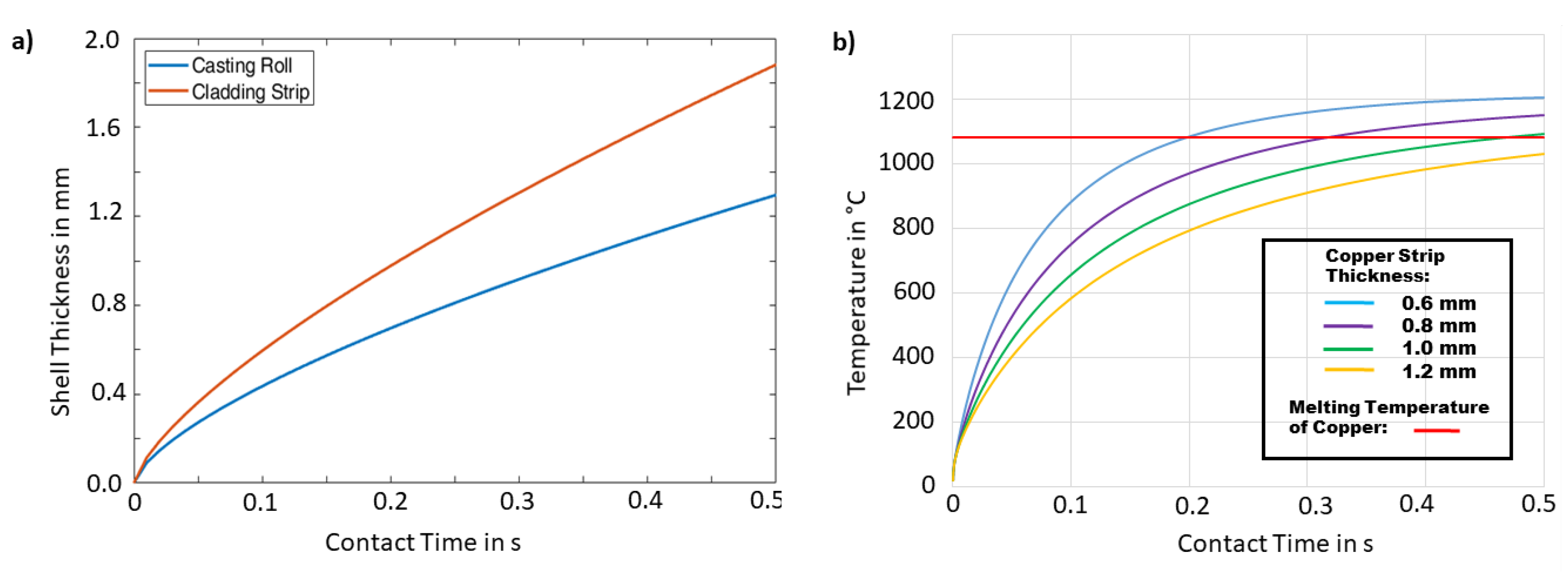




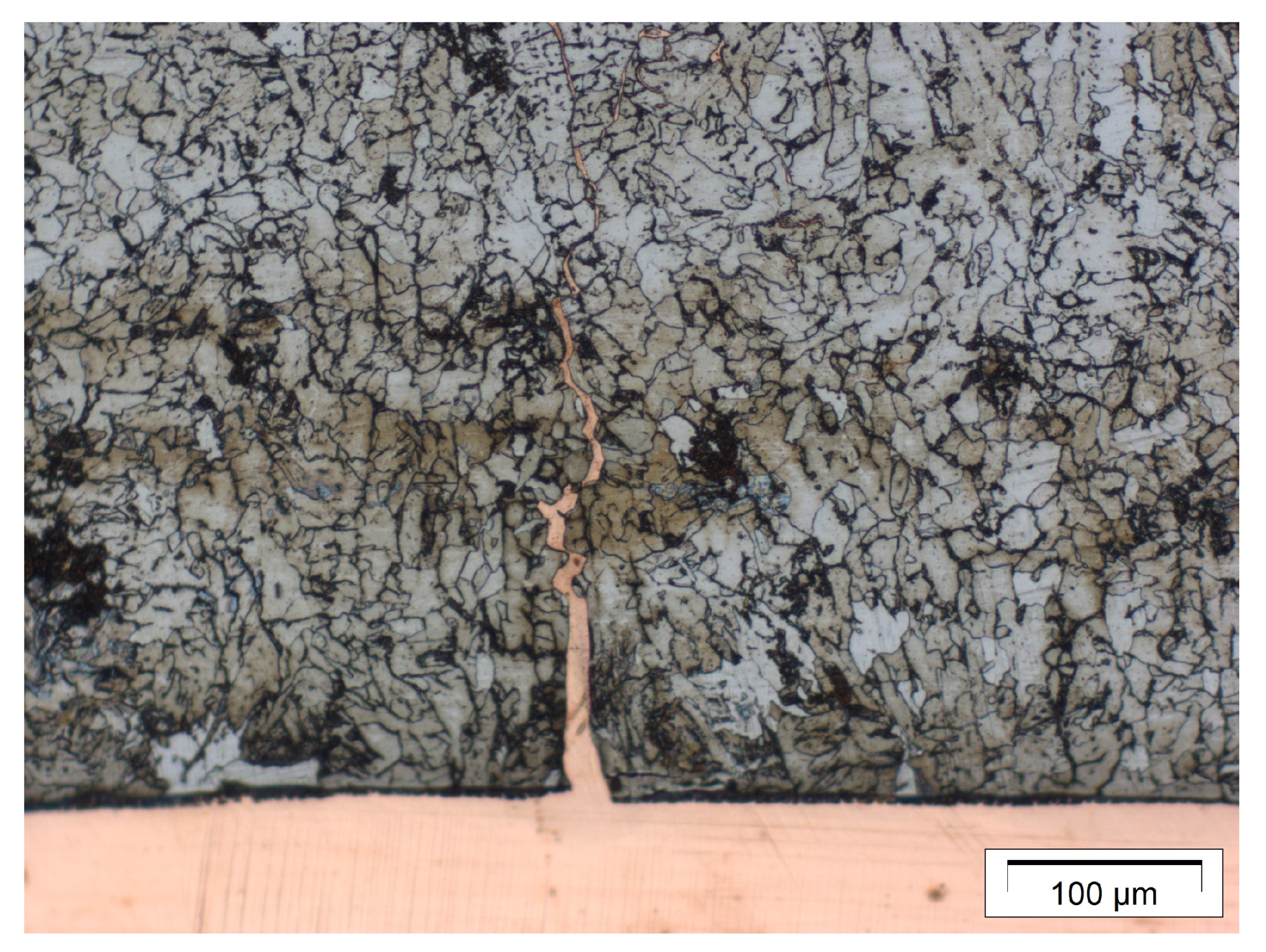
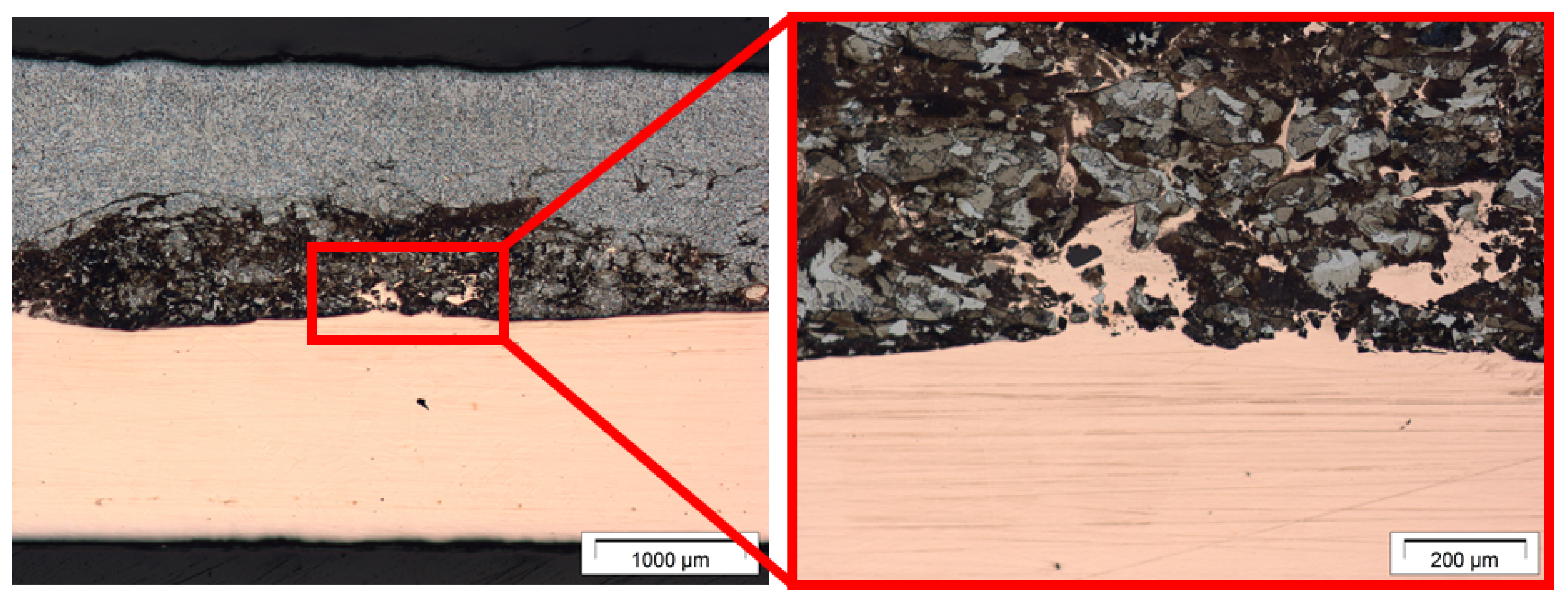
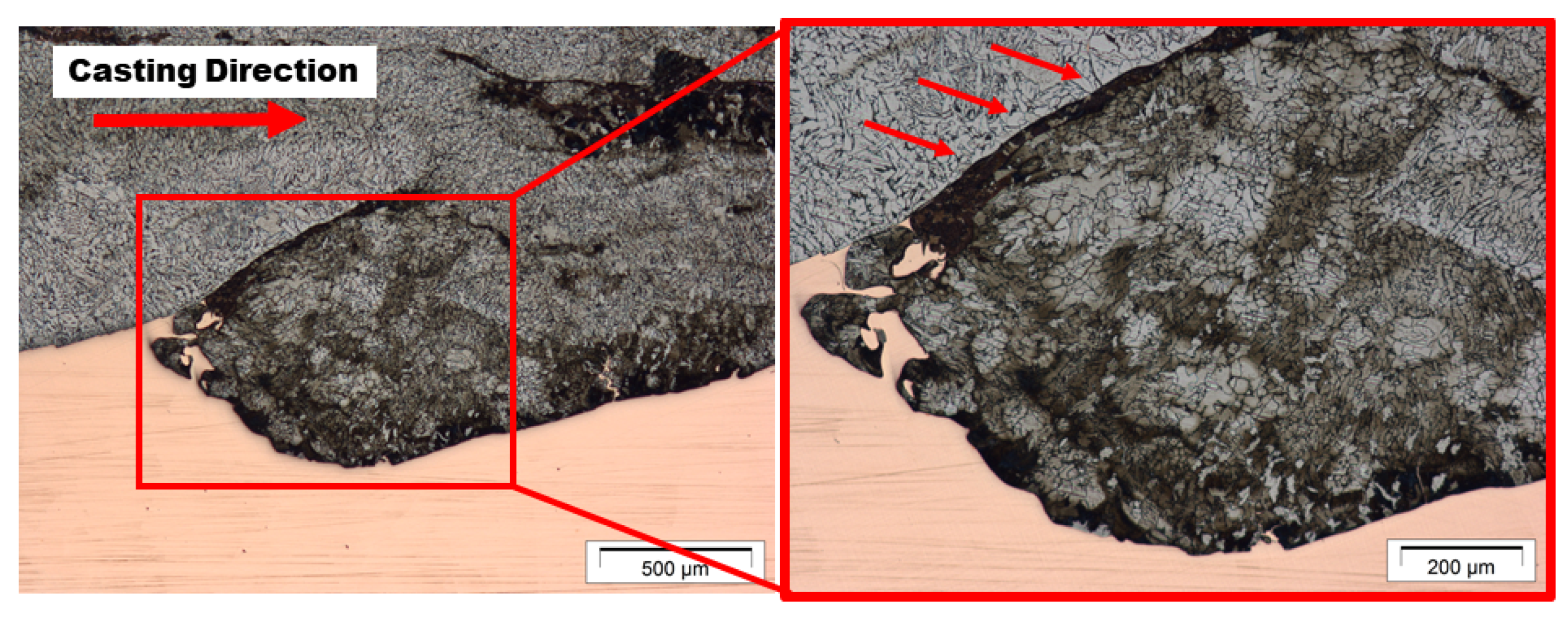


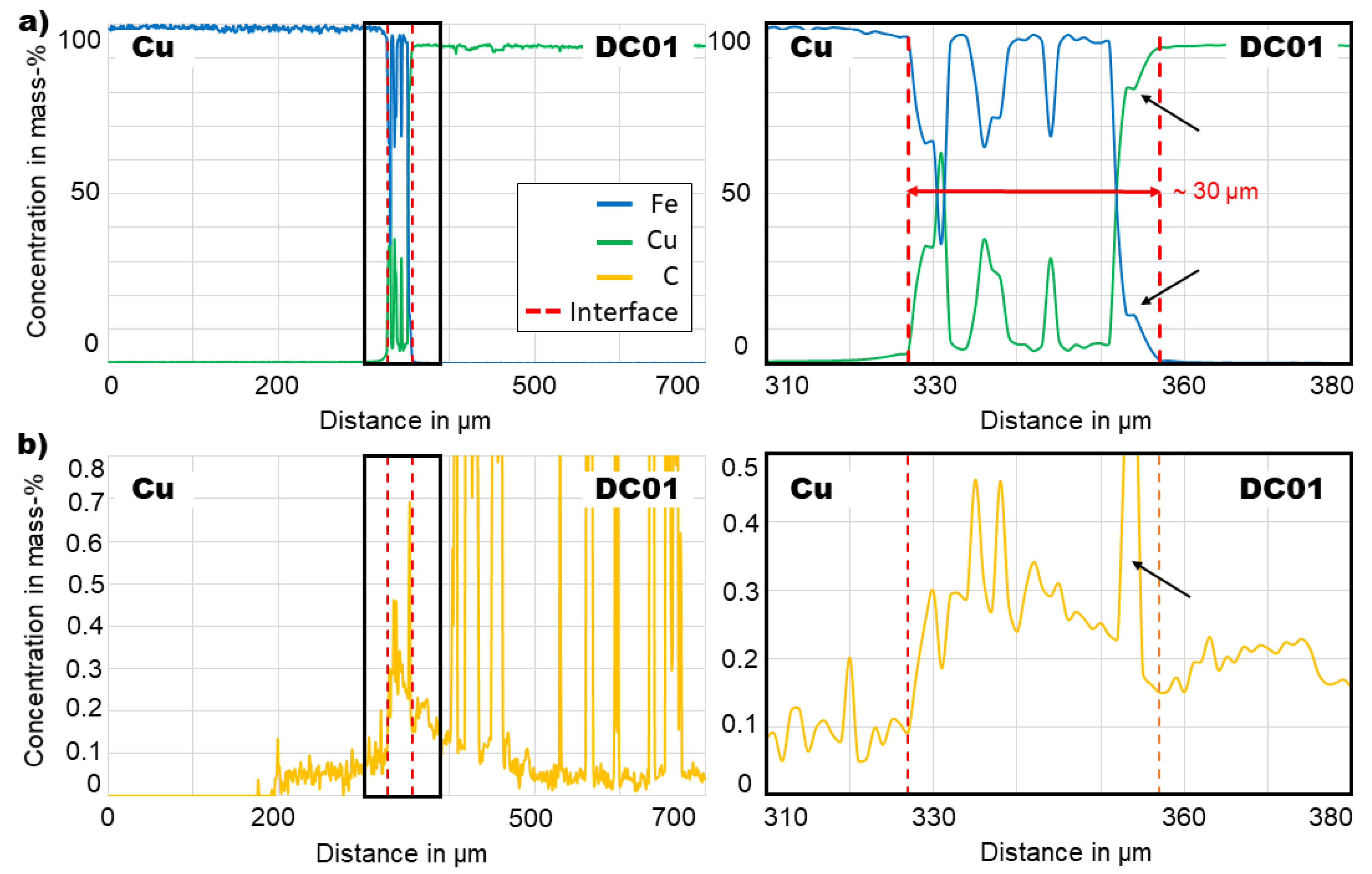


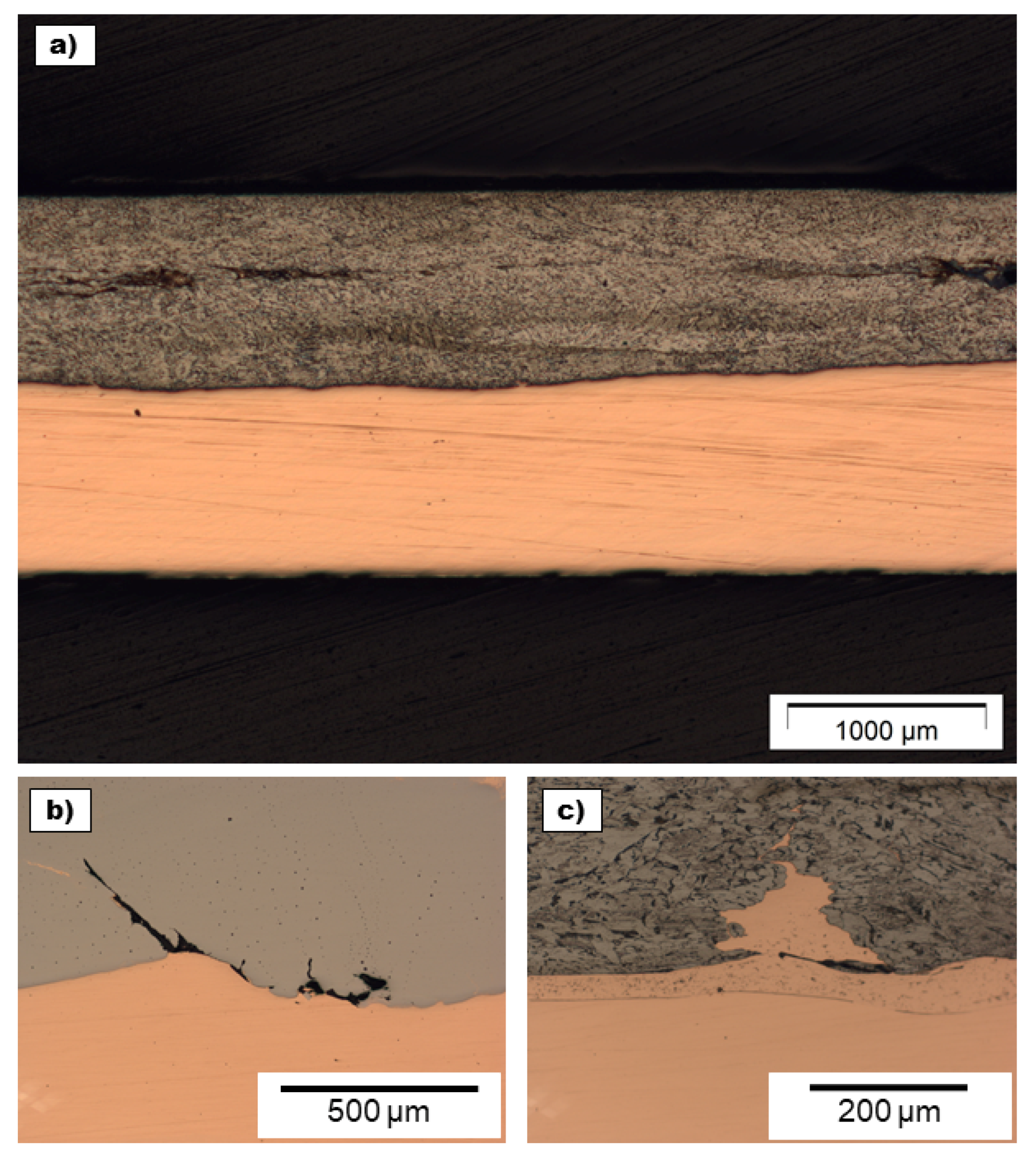

© 2019 by the authors. Licensee MDPI, Basel, Switzerland. This article is an open access article distributed under the terms and conditions of the Creative Commons Attribution (CC BY) license (http://creativecommons.org/licenses/by/4.0/).
Share and Cite
Münster, D.; Hirt, G. Copper Clad Steel Strips Produced by a Modified Twin-Roll Casting Process. Metals 2019, 9, 1156. https://doi.org/10.3390/met9111156
Münster D, Hirt G. Copper Clad Steel Strips Produced by a Modified Twin-Roll Casting Process. Metals. 2019; 9(11):1156. https://doi.org/10.3390/met9111156
Chicago/Turabian StyleMünster, Dennis, and Gerhard Hirt. 2019. "Copper Clad Steel Strips Produced by a Modified Twin-Roll Casting Process" Metals 9, no. 11: 1156. https://doi.org/10.3390/met9111156



